
Susan Parriott joined the Alzheimer’s Association Minnesota-North Dakota Chapter as the chief executive officer in 2012 and became the Region 5 Leader for the Association in January 2017 managing the Association’s operations in Minnesota, North Dakota, Iowa, Nebraska, South Dakota and Wisconsin. At the Association, Parriott has expanded care and support services, including programs focused on diversity and inclusivity. She has advanced public policy at the state and federal levels, with legislation for Alzheimer’s research and support being passed every year in Minnesota and increased state funding in the North Dakota Dementia Care Services Program, a program that provides services and support across the state. For two years, the chapter hosted the largest Walk to End Alzheimer’s® in the country, raising $1.7 million, and the event continues to be in the top five of Walk to End Alzheimer’s across the country.
Under Parriott’s leadership, the Minnesota-North Dakota Chapter has achieved all strategic plan goals every year since 2013 and the chapter has doubled its funding. Before joining the Alzheimer’s Association, Parriott served as the executive director of The ALS Association, Minnesota/North Dakota/South Dakota Chapter for eleven years, where she substantially grew its revenue allowing the chapter to expand its services and service area to include North and South Dakota. Prior to her work with ALZ, she was the executive director of the Pearson Lakes Arts Center in Okoboji, Iowa. Parriott has been a proud member of Rotary since 1999.
What is the Alzheimer’s Association?
The Alzheimer’s Association is a national non-profit organization that leads the way to end Alzheimer’s and all other dementia — by accelerating global research, driving risk reduction and early detection, and maximizing quality care and support. Our organization provides no-cost care and support programs for people impacted by the disease, advocates for federal and state resources and legislation, and funds research projects in 56 countries.
What was your professional journey that led you to working for the Alzheimer’s Association?
My undergraduate degrees are in journalism and speech. My first job out of college was as a television news producer which was extremely stressful. After moving back to my hometown, I went to work for the Pearson Lakes Art Center. I had volunteered at this non-profit and many others for several years and was knowledgeable about fundraising and working with volunteers. When I moved to Minneapolis I went to work for The ALS Association as the Executive Director for the Minnesota Chapter. I expanded that chapter to also cover North and South Dakota. After 11 years, it was time for a new challenge and the Executive Director position with the Alzheimer’s Association opened up. I came on board in 2012 and then became the Regional Leader, serving a six-state area, six years later.
Can you share some things your organization has done that you are most proud of?
I am very proud of our efforts in fundraising and how we have mobilized our communities to care about this cause and join us in seeing an end to this devastating disease. Our annual Purple Gala raises more than $1 million and our Twin Cities Walk to End Alzheimer’s achieved nearly $1.7 in contributions. Our NIH funding for ALZ research has been increased from $500 million to almost $4 billion dollars annually. In the last year, our organization and volunteer advocates mobilized to influence CMS to cover PET scans and the approval of the first treatments available to slow the progression of Alzheimer’s disease. In our chapter, we have expanded our DE&I program, building 30 partnerships across our two states. We have also increased funding of Alzheimer’s research in MN to $1 million dollars per year.
What motivates you as a leader?
I love our mission and the thought of truly changing the world for all those impacted by Alzheimer’s or another dementia. As a leader, I am personally motivated to achieve our Association’s goals and to help our staff reach them. I am committed to developing staff for their next opportunity, while keeping them engaged with our organization.
What advice would you give to aspiring healthcare leaders who are looking to make an impact in this industry?
There are so many areas that people can get involved in. Find one that you are passionate about and that will make all the difference. If you can’t find a position right away, volunteer and learn more about the area you are interested in.
How do you see the healthcare industry changing in the next 5-10 years, and what is your organization doing to stay ahead of those changes?
I think AI is going to play a big part in our healthcare systems. It should help make things easier, but we have to keep care patient-centered. I think as we are able to look at each individual and provide the appropriate care we’ll have better results than cookie cutter care. There are so many comorbidities that people have, especially as they live longer- we’ll need to determine how to best manage them and I am hopeful that AI can assist with that,
How does your company prioritize diversity, equity, and inclusion, both in terms of your workforce and the services you offer?
One of our five organizational pillars is DE&I. Because so many underrepresented communities have a higher prevalence of Alzheimer’s and dementia, DE&I is even more critical in our work. These efforts are embedded in all of our departments and we are committed to expanding our collaborations and partnerships with external organizations in order to further this work. Our staff receives annual DE&I training and we set annual performance goals across the organization related to this important work.
What are your hobbies or things you enjoy doing when not at work?
I enjoy walking, reading, playing golf, watching movies and sports, wine tastings and spending time with my family and friends.
